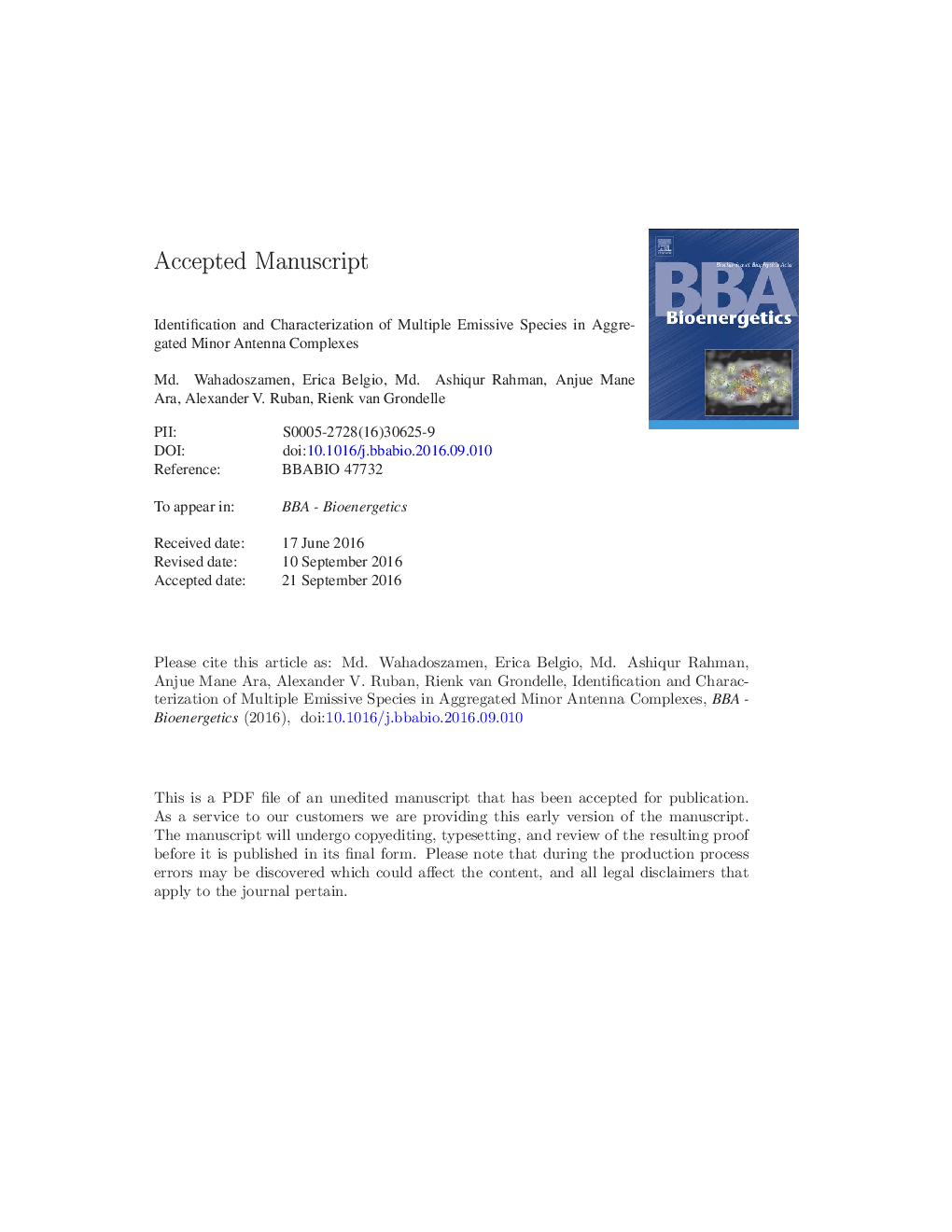| کد مقاله | کد نشریه | سال انتشار | مقاله انگلیسی | نسخه تمام متن |
|---|---|---|---|---|
| 5507289 | 1400324 | 2016 | 31 صفحه PDF | دانلود رایگان |
عنوان انگلیسی مقاله ISI
Identification and characterization of multiple emissive species in aggregated minor antenna complexes
ترجمه فارسی عنوان
شناسایی و مشخص نمودن گونه های مضر متعدد در مجموعه های آنتن کم حجم
دانلود مقاله + سفارش ترجمه
دانلود مقاله ISI انگلیسی
رایگان برای ایرانیان
کلمات کلیدی
موضوعات مرتبط
علوم زیستی و بیوفناوری
علوم کشاورزی و بیولوژیک
دانش گیاه شناسی
چکیده انگلیسی
Aggregation induced conformational change of light harvesting antenna complexes is believed to constitute one of the pathways through which photosynthetic organisms can safely dissipate the surplus of energy while exposed to saturating light. In this study, Stark fluorescence (SF) spectroscopy is applied to minor antenna complexes (CP24, CP26 and CP29) both in their light-harvesting and energy-dissipating states to trace and characterize different species generated upon energy dissipation through aggregation (in-vitro) induced conformational change. SF spectroscopy could identify three spectral species in the dissipative state of CP24, two in CP26 and only one in CP29. The comprehensive analysis of the SF spectra yielded different sets of molecular parameters for the multiple spectral species identified in CP24 or CP26, indicating the involvement of different pigments in their formation. Interestingly, a species giving emission around the 730Â nm spectral region is found to form in both CP24 and CP26 following transition to the energy dissipative state, but not in CP29. The SF analyses revealed that the far red species has exceptionally large charge transfer (CT) character in the excited state. Moreover, the far red species was found to be formed invariably in both Zeaxanthin (Z)- and Violaxathin (V)-enriched CP24 and CP26 antennas with identical CT character but with larger emission yield in Z-enriched ones. This suggests that the carotenoid Z is not directly involved but only confers an allosteric effect on the formation of the far red species. Similar far red species with remarkably large CT character were also observed in the dissipative state of the major light harvesting antenna (LHCII) of plants [Wahadoszamen et al. PCCP, 2012], the fucoxanthin-chlorophyll protein (FCP) of brown algae [Wahadoszamen et al. BBA, 2014] and cyanobacterial IsiA [Wahadoszamen et al. BBA, 2015], thus pointing to identical sites and pigments active in the formation of the far red quenching species in different organisms.
ناشر
Database: Elsevier - ScienceDirect (ساینس دایرکت)
Journal: Biochimica et Biophysica Acta (BBA) - Bioenergetics - Volume 1857, Issue 12, December 2016, Pages 1917-1924
Journal: Biochimica et Biophysica Acta (BBA) - Bioenergetics - Volume 1857, Issue 12, December 2016, Pages 1917-1924
نویسندگان
Md. Wahadoszamen, Erica Belgio, Md. Ashiqur Rahman, Anjue Mane Ara, Alexander V. Ruban, Rienk van Grondelle,
